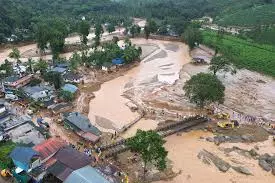Damming effect may have triggered Wayanad landslides: Expert

Thiruvananthapuram: The damming effect may have triggered the massive landslides in Wayanad district on July 30 which caused huge devastation in the region.
John Mathai, a senior scientist at the National Centre for Geosciences and head of the expert committee constituted by the Kerala government, revealed this information while surveying the affected areas of Mundakkai, Chooralmala, and Punjarimattom. "The region experienced more than 570 mm of rainfall within three days. The water flowing downhill likely accumulated downstream, creating a damming effect. A damming occurs when a barrier forms downstream following heavy rainfall, leading to the accumulation of a large volume of water. The second cloudburst may have broken this barrier, causing a deluge of water to rush downhill at high speed, uprooting trees and sweeping along massive boulders and rocks. This happened eight km downstream," he explained to the media on Thursday.
So far 231 bodies and 221 body parts have been recovered from the disaster-hit areas. As many as 118 persons are still missing.
Mathai noted that climate change has significantly altered the rainfall patterns in Wayanad and Idukki districts. Previously, the rainfall was more prolonged, but recent data indicates a shift towards cloudburst-type rainfall, characterized by intense downpours in brief periods over small areas, leading to rapid water flow downstream at high speeds. This rapid flow can create a snowball effect, dragging along boulders, trees, and rocks from the hilltop, he said.
Concerning the region's safety for habitation, Mathai mentioned that his team has assessed the landslide-affected areas of Pujarimattam and Chooralmala. They are currently categorizing the peculiarities of each area into safe and unsafe zones, with plans to present their findings to the government. The regions along the river in Punjarimattom continue to be danger zones. “It is advisable to avoid residing in these areas. Although a significant landslide may not recur shortly after a major one, the territory claimed by the river should remain undisturbed. As we call “room for river”, space must be allotted for the river, and people may utilize the remaining land,” he added.
Mathai noted that, in comparison to Punjarimattom, the majority of the Chooralmala region is safe. Nevertheless, the decision to permit habitation there rests with the government. It is a policy matter that the government needs to address regarding construction. Modern construction technologies exist to ensure safety in such areas, but they come at a substantial cost. Therefore, the government will have to make policy decisions on these matters.
Gadgil recommends Goa model of homestay tourism for Wayanad
Renowned environmentalist Madhav Gadgil recommended Goa's model of homestay tourism for Wayanad, following the recent devastation from landslides. He noted that large resorts have a significant impact on nature, particularly in ecologically sensitive areas like Wayanad.
Gadgil shared these observations in a video message during an environmental conservation conference hosted by the Nature Conservation Committee in Kalpetta.
He also mentioned that labour cooperative societies should take over the tea plantations.
Madhav Gadgil stated that the rehabilitation of landslide victims in Wayanad requires proper implementation. In the past, the rehabilitation following similar natural disasters, including those in Maharashtra, was not conducted adequately.
Gadgil said the management of mining activities, including those in Kerala, should be handed over to local communities. The majority of Kerala's quarries are operating illegally within the state, he alleged.
He suggested that the government should assume control of all quarries and assign the Kudumbashree teams to manage them in Kerala.
